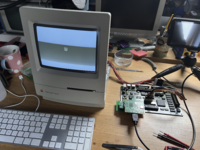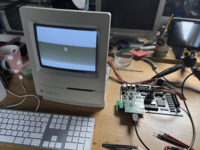"We have a small corner on our discord server dedicated to 68k Mac and Atari. Especially the Atari folks made huge progress in recent times. I think Mac can benefit from this progress too."
I was able to get the PiStorm to "work" with a Macintosh Classic, in that it was able to boot up from a floppy disk and putter around the OS. It took about two day's worth of time spread over an entire year to get to this point.

I had to use an early version of the Atari firmware due to the current main branch completely lacking any form of bus arbitration, which the Atari and Macintosh depend upon heavily. SCSI didn't work and the machine was very crash-happy. None of PiStorm's fancy RAM and ROM overlaying features work at present. There have been reports of people getting PiStorm to "work" in the Macintosh Plus and SE but the community as a whole (honestly, myself included) has done a terrible job of keeping good notes of what they are doing with which hardware in which systems.
Besides the geometric issues of cramming Pi+FPGA onto a logic board with near-zero wriggle room, the overriding problem with trying to get PiStorm into the Classic in particular is power. When powered by the Classic's logic board as pictured, the Pi 3 constantly complains about low voltages, even when undervolted and underclocked (a counterproductive measure when trying to build a performance upgrade). Stepping up to the even more power-hungry Pi 4 to try testing the newest Atari firmware jeopardises the whole Mac, which I am not keen on doing at all. This issue with power delivery will be shared by all the compact 68000 Macs that do not have discrete PSUs, namely the 128K, 512K, and Plus.
The "official" Macintosh mode of PiStorm is all but non-existent. It is not being actively developed and the "Mac" stuff you get when installing main branch PiStorm does not work in any system as far as I have seen.
PiStorm as a project and as a community is fairly chaotic. Scope creep and a predominant interest in Amiga systems have turned a general-purpose 68000 hardware emulator into what is essentially an Amiga-specific upgrade with absolutely anything unnecessary trimmed off at the CPU emulation level (and a bunch of Amiga-specific enhancements crammed in at the user end). Most PiStorm versions for non-Amiga systems have fallen off main branch and landed in their own forks by now. There is not currently a fork for Macintosh, although I am very slowly working toward it.
There are myriad combinations of various PiStorm boards, PiStorm firmwares, PiStorm emulator versions, host Pis, and adapters with absolutely no central database or webpage detailing the differences and expected behaviours therein. Getting up to speed with the project involves reading a backlog of thousands of Discord messages.
All this is not to be construed as an outright criticism of PiStorm itself, as I have had many positive interactions with the folks behind it and think that the project is itself still impressive and worth exploring further. That said, those who are hoping for anything PiStorm-related in their Mac any time soon can expect a good, long wait. The pieces are all there, they just haven't been pieced together yet and doing so will take a long time. If an expert were to rock up intent on building a fully-fledged Mac version of PiStorm it would probably not take them very long to put all the pieces together and build a drop-in replacement for 68000-based Macs. Sadly, I am a rank amateur when it comes to programming and all that I have achieved with is project has been from standing on the shoulders of giants.
I'm currently in the middle of a month-long effort to get my workspace back into a usable state, which has been hampered by my frankly awful mental health. Hopefully some time soon I will get back to this project and give it a little bit of momentum.
TL;DR: PiStorm has been developed in ignorance of the 68000's specification in order to more quickly get it working for Amiga. There is no stable or usable PiStorm for Mac and there will not be any time soon.




